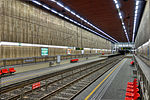Tir national
1889 establishments in BelgiumBuildings and structures completed in 1889Buildings and structures demolished in 1963Buildings and structures in BrusselsExecution sites ... and 4 more
SchaerbeekShooting ranges in BelgiumWorld War II sites in BelgiumWorld War I sites in Belgium

The National shooting range (French: Tir national, Dutch: Nationale Schietbaan) was a firing range and military training complex of 20 hectares (49 acres) situated in the municipality of Schaerbeek in Brussels. During World Wars I and II the site was used for the executions of civilians, prisoners and captured members of the resistance.
Excerpt from the Wikipedia article Tir national (License: CC BY-SA 3.0, Authors, Images).Tir national
Rue Colonel Bourg - Kolonel Bourgstraat,
Geographical coordinates (GPS) Address Nearby Places Show on map
Geographical coordinates (GPS)
| Latitude | Longitude |
|---|---|
| N 50.853 ° | E 4.407 ° |
Address
Rue Colonel Bourg - Kolonel Bourgstraat 92
1030
Belgium
Open on Google Maps







